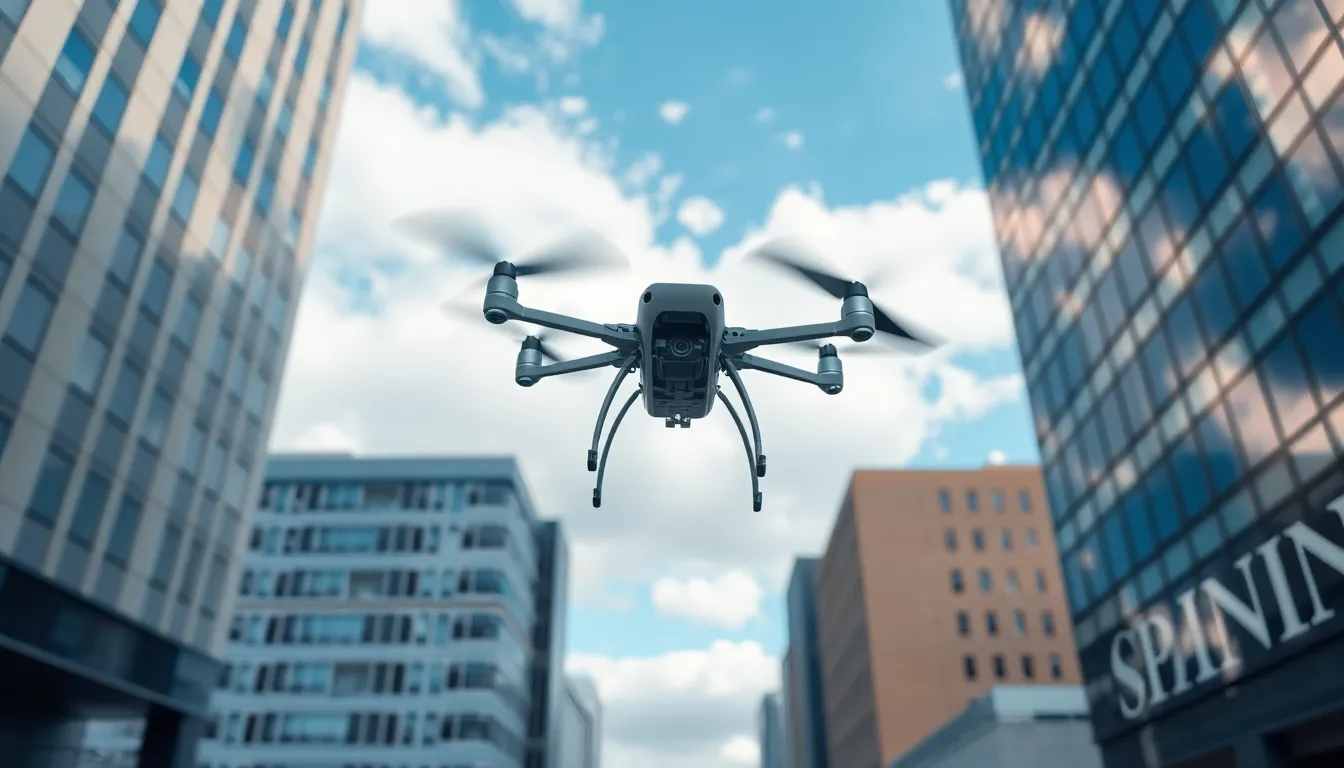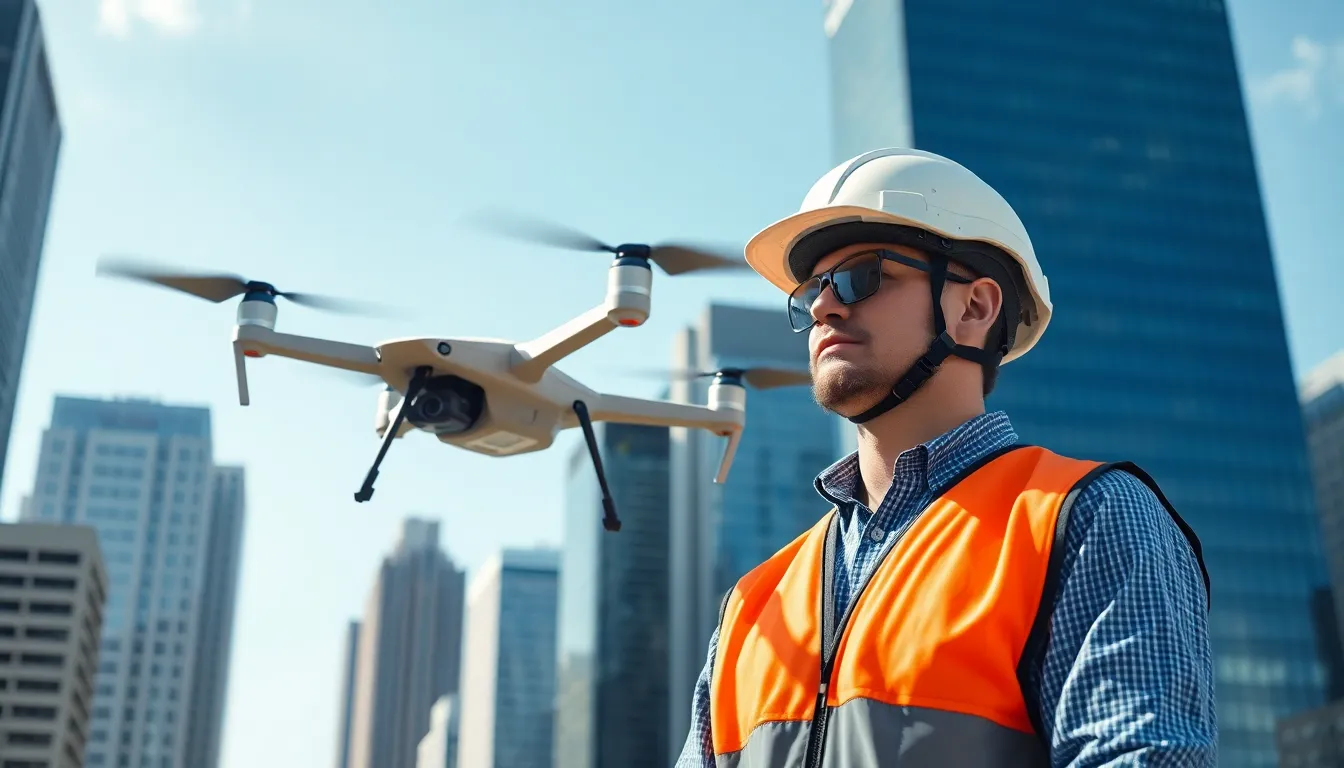Imagine a world where flying cars aren’t just a dream but a reality, and VTOL drones are leading the charge. These vertical takeoff and landing marvels are not just for tech enthusiasts; they’re transforming industries from delivery services to emergency response. With the ability to hover, zip, and land in tight spaces, they’re like the superheroes of the skies—minus the capes.
Table of Contents
ToggleWhat Are VTOL Drones?
VTOL drones, or vertical takeoff and landing drones, represent a significant advancement in aerial technology. These machines combine the benefits of fixed-wing and rotary-wing designs, enabling them to hover, take off, and land vertically. Their versatile flight capabilities make VTOL drones suitable for various applications.
Delivery services increasingly rely on VTOL drones for efficient and timely transportation. Companies such as Amazon and Zipline leverage these drones to deliver packages and critical medical supplies, respectively. They navigate urban environments efficiently, reducing delivery times in congested areas.
Emergency response sectors also benefit from VTOL drones. They facilitate rapid deployment in disaster zones, allowing medical personnel to reach patients quickly. Equipped with surveillance technology, these drones provide real-time data, aiding in assessing situations effectively.
Environmental monitoring utilizes VTOL drones to gather data in hard-to-reach areas. Researchers deploy them for wildlife observation, air quality assessment, and mapping terrains. Their agility enables precise data collection without disturbing natural habitats.
Manufacturers design VTOL drones for various weights and purposes. Small models may carry lightweight packages or perform aerial photography, while larger variants handle heavy cargo transport. Innovations in battery technology enhance flight endurance, enabling longer missions.
Overall, VTOL drones offer transformative potential across numerous industries. Their unique capabilities foster advancements in logistics, emergency care, and environmental science. The ongoing development of this technology promises to reshape how society interacts with aerial transportation.
Advantages of VTOL Drones

VTOL drones offer distinct advantages that enhance various operations across industries. Their capabilities ensure efficiency and practical applications in numerous environments.
Increased Mobility
Increased mobility remains one of the most significant benefits of VTOL drones. These aircraft can take off and land vertically, which allows access to confined urban areas without requiring traditional runways. They navigate congested regions much easier, ensuring timely deliveries and rapid responses. The ability to hover precisely enhances their functionality in search and rescue operations. Quick transitions between vertical and horizontal flight improve their versatility. Businesses leveraging this mobility gain a competitive edge in logistics and emergency services.
Flexible Operations
Flexible operations distinguish VTOL drones from conventional aircraft. They adapt to diverse missions, whether transporting packages or conducting surveillance. VTOL drones can perform tasks in varying weather conditions and terrains, increasing their usability. Configurable payloads allow them to switch functions without complex adjustments. Their design promotes ease of integration into existing systems, facilitating operations across different industries. Organizations benefit from cost-effective solutions that maximize productivity and speed, making these drones an invaluable asset in modern aerial applications.
Applications of VTOL Drones
VTOL drones find utility across various sectors, significantly impacting commercial and military operations.
Commercial Use
In commercial applications, companies leverage VTOL drones for efficient package delivery, including medical supplies and retail items. Amazon and Zipline exemplify organizations utilizing these drones for quick transportation in urban landscapes. Businesses appreciate the drones’ ability to access tight spaces, which enhances service delivery speeds. Environmental initiatives also benefit from using VTOL drones to monitor wildlife and assess air quality. Real-time data collection makes operations more effective. With advancements in battery technology, drones can undertake longer missions while minimizing costs. These capabilities support businesses in enhancing logistics and improving overall customer satisfaction.
Military Use
Military applications of VTOL drones include surveillance, reconnaissance, and logistics support. Forces utilize these drones for intelligence-gathering missions in remote or hostile environments where traditional aircraft face challenges. Rapid deployment allows military units to respond effectively to dynamic situations. The ability to access confined areas enables precise targeting and operational flexibility. Additionally, VTOL drones support supply deliveries to frontline troops, ensuring timely access to essential resources. Their endurance and adaptability make them valuable assets in contemporary military strategies. This versatility increases mission success rates while reducing risks for personnel.
Challenges Facing VTOL Drones
Challenges arise as VTOL drones become more integrated into various sectors. These hurdles include regulatory issues and technical limitations.
Regulatory Issues
Governments worldwide need to establish clear guidelines for VTOL drone operations. Regulations currently lag behind the rapidly evolving technology, causing uncertainty for manufacturers and operators. Compliance with air traffic control and ensuring public safety remain top priorities in drafting these regulations. Different countries present unique challenges, necessitating a comprehensive understanding of local laws. Additional concerns about privacy and noise pollution complicate the regulatory landscape, influencing public perception and acceptance. Consistent collaboration among stakeholders, including government bodies, manufacturers, and communities, plays a crucial role in shaping effective regulations.
Technical Limitations
Technical constraints hinder the full potential of VTOL drones. Battery life poses a significant challenge, as many models struggle with limited energy capacity affecting flight range. Payload capacity also impacts their usability, with many drones unable to transport heavy or bulky items efficiently. Weather conditions further challenge drone operations, limiting functionality during high winds or precipitation. Additionally, operational reliability requires robust communication systems to maintain connectivity during flights. Continuous research and development efforts focus on overcoming these limitations, aiming to enhance the capabilities and reliability of VTOL drones in diverse applications.
Future of VTOL Drones
Future advancements in VTOL drones promise transformative changes across industries. New designs focus on increasing efficiency and versatility, aiming to enhance urban mobility and logistics. Companies invest in developing improved battery technology, which leads to greater flight endurance and range.
In delivery services, VTOL drones could soon handle larger payloads, revolutionizing e-commerce and package transportation. Utilization in emergency response is expected to expand, providing more immediate assistance during natural disasters. Constant improvements in navigation systems enhance precision, ensuring optimal flight paths and safety.
Safety regulations play a crucial role in the future landscape of VTOL operations. Authorities work toward establishing comprehensive guidelines, addressing air traffic management and public safety. Collaboration between governments and manufacturers will create a balanced regulatory environment, facilitating smooth integration into civilian airspace.
Innovative use cases continue to emerge as technology matures. Environmental monitoring applications benefit from real-time data collection, aiding wildlife conservation and urban air quality assessment. Military applications also explore advanced capabilities, such as enhanced reconnaissance and tactical support.
As these drones become mainstream, public perception will shape future developments. Increasing awareness of their benefits can lead to broader acceptance. Significantly, concerns about privacy and noise pollution must be considered to ensure community support for operational expansion.
Overall, the next decade for VTOL drones appears promising, with continuous evolution driving progress. Investment in research and development will unlock new possibilities, positioning VTOL drones as essential tools for modern transport and logistics.
VTOL drones are set to redefine the landscape of aerial transportation and logistics. Their unique capabilities allow for rapid deployment and access to hard-to-reach areas, making them indispensable in both commercial and emergency applications. As technology advances and regulations evolve, these drones will likely become even more integrated into daily operations across various sectors.
The ongoing innovations in battery technology and flight endurance promise to unlock new possibilities, enhancing efficiency and versatility. With a focus on addressing regulatory and technical challenges, the future of VTOL drones looks bright. They’re not just a glimpse into the future; they’re actively shaping how industries operate and respond to challenges in real-time.



